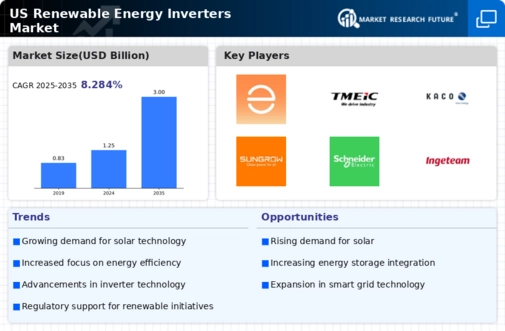The US Renewable Energy Inverters Market is characterized by a dynamic competitive landscape, driven by the increasing demand for renewable energy sources such as solar and wind power. As the shift toward sustainable energy accelerates, inverter manufacturers are focusing on enhancing efficiency, reliability, and integration with advanced technologies. The market is marked by a mix of established players and emerging startups, each vying to capture a share through innovation, strategic partnerships, and the development of tailored products suited to the evolving needs of consumers and businesses.
Regulatory frameworks and incentives also play a crucial role in shaping competitive strategies as companies adapt to meet changing energy policies and grid infrastructure demands.
The ongoing evolution of smart technology and the Internet of Things further influences the competitive dynamics, pushing companies to innovate their solutions to stay ahead in this rapidly growing sector.Enphase Energy has established a strong foothold in the US Renewable Energy Inverters Market, known for its microinverter technology that enhances solar power generation efficiency. Its innovative approach, focusing on individual module optimization, has resonated well with both residential and commercial customers looking for reliable and high-performing solar solutions. The company's commitment to product quality and customer service has further solidified its reputation in the market.
Enphase's strengths lie in its robust distribution network and a strong brand presence that allows it to effectively reach its target customers.
The company's continuous investment in research and development ensures that it remains at the forefront of technological advancements, enabling it to offer cutting-edge solutions that cater to various consumer needs while maintaining a significant competitive edge.ABB, another key player in the US Renewable Energy Inverters Market, is recognized for its comprehensive portfolio of products that includes a wide range of solar inverters and energy storage systems.
The company's strength lies in its extensive experience within the energy sector, complemented by a solid reputation for quality and reliability. ABB's market presence is reinforced by its strategic partnerships and collaborations, which enhance its ability to innovate and expand its offerings. The company frequently engages in mergers and acquisitions, allowing it to integrate new technologies and expand its capabilities in renewable energy solutions. ABB's focus on digital transformation and smart grid technologies positions it favorably to meet the increasing demand for efficient energy management systems in the US market.
Its ability to leverage advanced technologies in its product lines further strengthens its offerings, making it a significant competitor in the rapidly evolving landscape of renewable energy inverters.





















